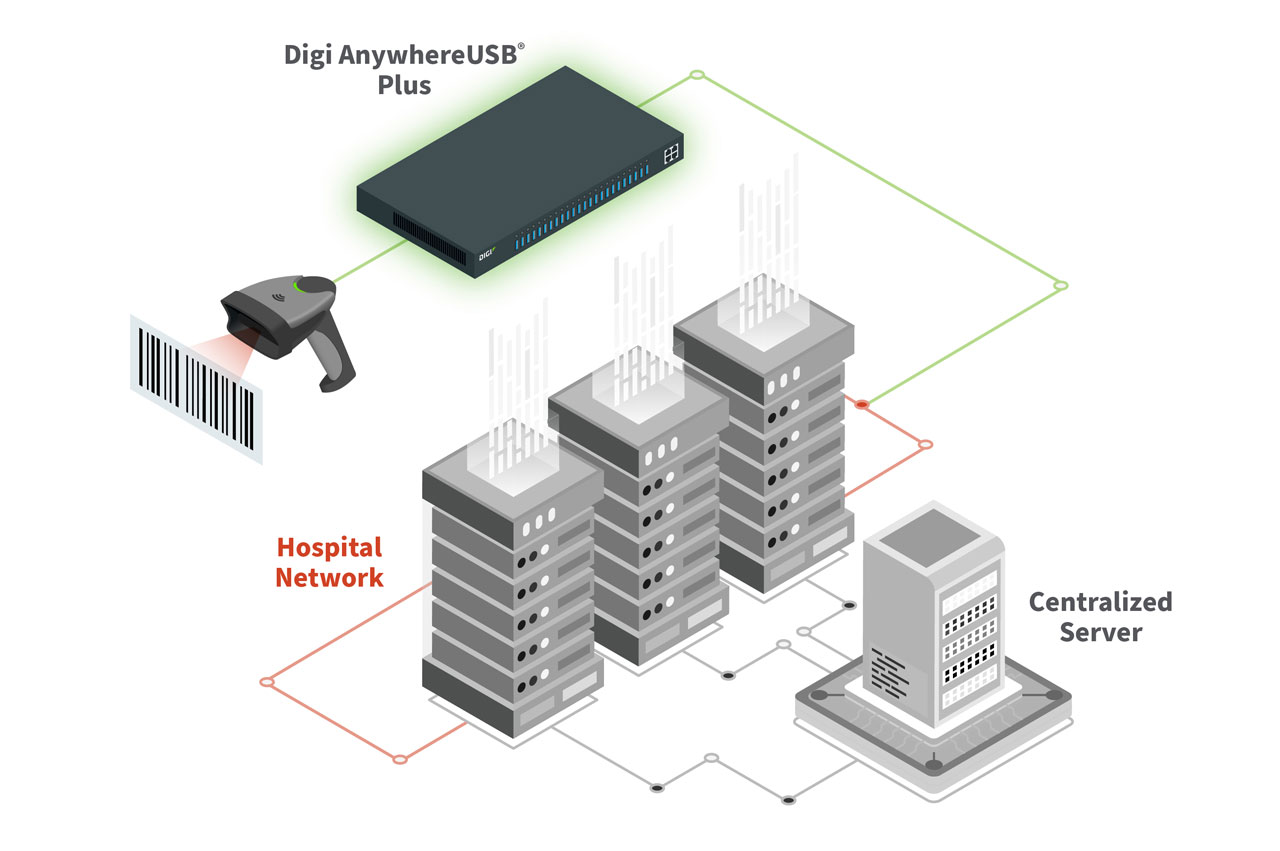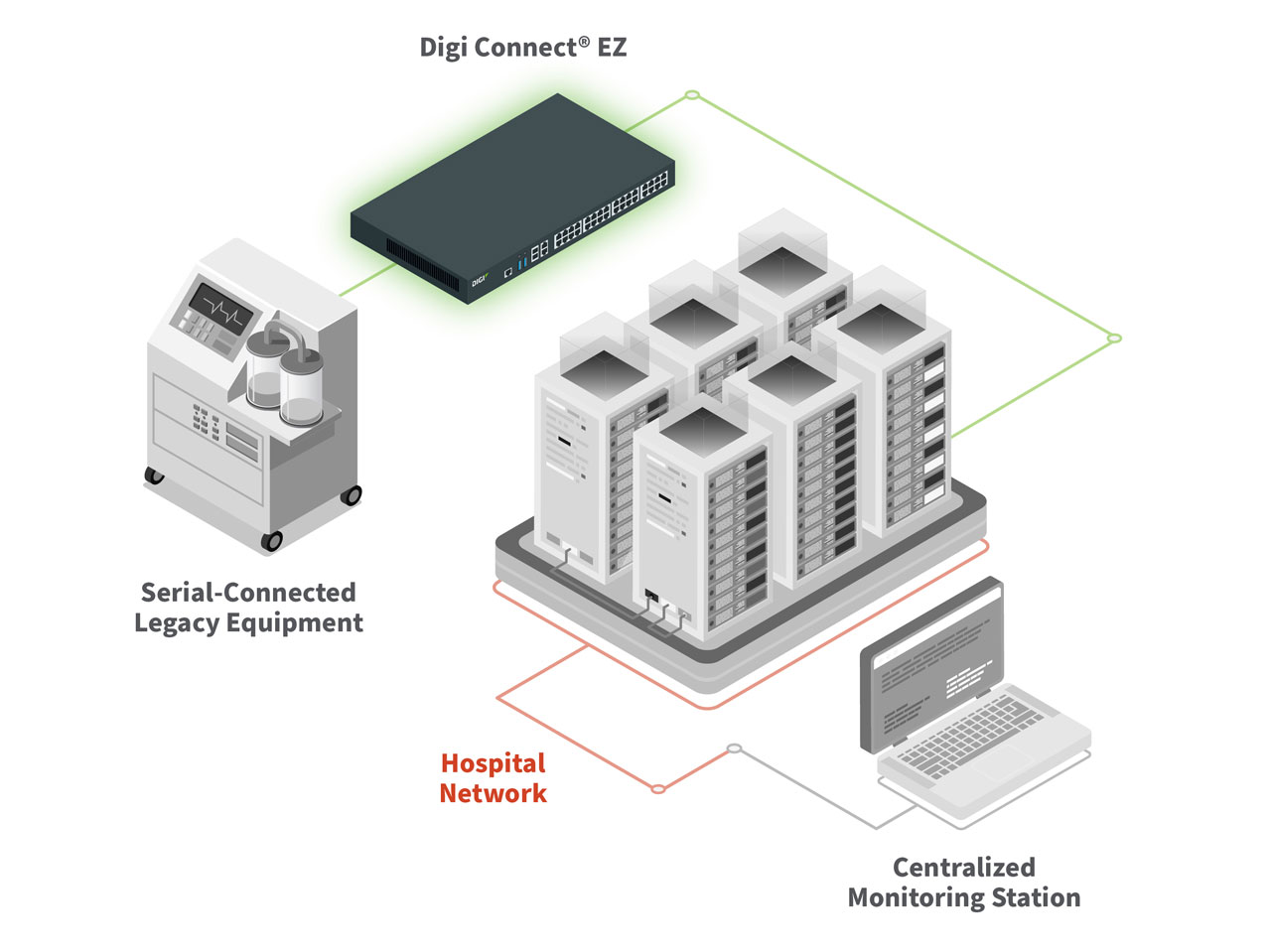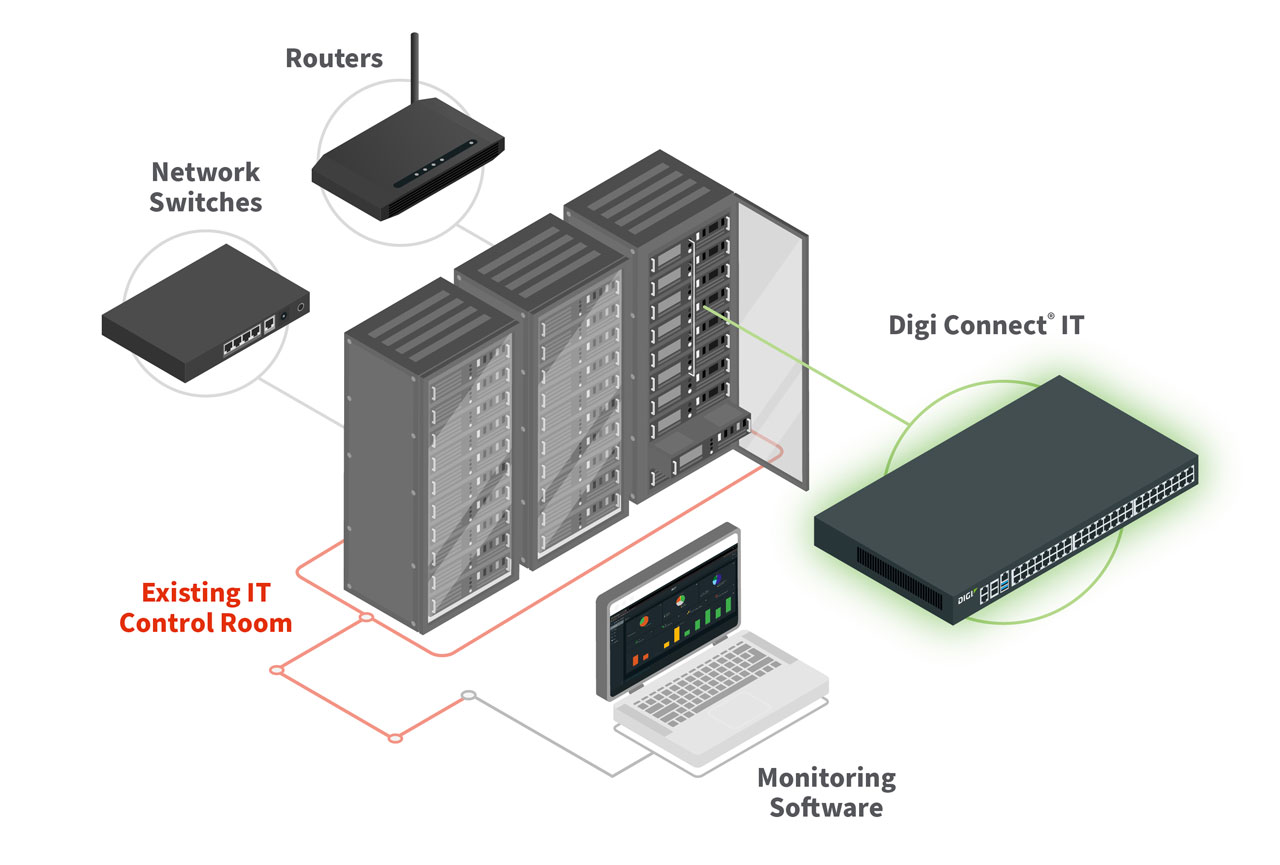Hospitals rely on secure, scalable IT to manage patient care and operations. Legacy medical devices, network security, and data transmission present challenges. Digi’s Healthcare Infrastructure Management Solutions optimize operations, enhance security, and reduce downtime.
Get Our Solution Brief
Learn more about infrastructure management solutions for connected healthcare
Download PDF
USB Over IP Connectivity in Healthcare
Managing USB-connected devices across hospitals is complex. Barcode scanners, printers, and lab instruments need seamless integration. Digi AnywhereUSB® Plus extends USB connectivity over IP networks, enabling centralized, secure, remote access.

Benefits:
- Remote management: IT can control USB devices from anywhere
- Stronger security: Limits local USB access, reducing risks
- Scalability: Supports multiple devices over IP for easy expansion
Connecting Patient Monitoring and Laboratory Equipment to Modern Networks
Hospitals continue to require RS-232 serial connectivity for monitoring and laboratory equipment. Digi Connect EZ® serial device servers provide secure, scalable, and reliable RS-232 to Ethernet capability to integrate critical data into electronic health records (EHRs).

Benefits:
- Extends device lifespan: Keeps legacy medical tools functional
- Improves monitoring: Enables real-time data transmission
- Cuts costs: Avoids expensive device replacements
Securing and Managing Healthcare IT Networks
Hospitals need reliable network management for patient data, telemedicine, and security. Digi Connect® IT console servers provide out-of-band (OOB) network access, enabling remote IT troubleshooting.

Benefits:
- Stronger security: Encrypted access to network infrastructure
- Business continuity: Prevents downtime with remote troubleshooting
- Efficiency: Reduces on-site IT interventions
Digi’s Lifecycle Management and Security Solutions
Digi offers end-to-end security and lifecycle management to keep hospital IT systems compliant and efficient.

Benefits:
- Security: Shields hospital networks from cyber threats
- Proactive IT: Reduces downtime via remote monitoring
- Regulatory compliance: Helps hospitals meet security standards
Digi’s USB over IP, serial connectivity, and remote network tools help hospitals modernize IT, improve security, and streamline operations.
Upgrade your hospital’s infrastructure with Digi Healthcare IT Solutions: Digi Infrastructure Management.
Healthcare IT Infrastructure FAQ
What does “Healthcare IT Infrastructure” refer to in a hospital or clinical setting?
Healthcare IT infrastructure includes the hardware, networks, connectivity systems, data services, and management tools that support medical devices, administrative systems, electronic health records (EHRs), remote monitoring, and telehealth. It must integrate legacy medical devices, ensure data flows securely, and support modern digital services.
What are the biggest challenges hospitals face with legacy medical devices and connectivity?
- Many medical and lab devices use USB or RS-232 serial interfaces, which were not originally designed for networked operation. Hospitals struggle with integrating these devices into modern IP networks.
- Device replacement is costly—not only in hardware, but in regulatory compliance, training, and downtime. Keeping devices running longer, with network connectivity, often is the more pragmatic path.
- Local USB ports and physical access can lead to security risks, unauthorized usage, or maintenance challenges.
- Network management and resilience are critical: with many devices and systems, failure or downtime can have direct patient safety consequences.
What kinds of solutions does the blog highlight to modernize healthcare IT infrastructure?
- USB Over IP (AnywhereUSB Plus): This solution lets hospitals extend USB-connected devices (barcode scanners, lab instruments, printers) over IP networks. It centralizes access and management, and limits local USB exposure for security.
- Serial-to-Ethernet (Connect EZ): For devices with RS-232 interfaces (common in monitoring and lab equipment), Connect EZ allows conversion to Ethernet/ IP so that device data can stream into EHR systems and remote applications.
- Out-of-Band (OOB) Management and Console Servers (Connect IT): These tools provide encrypted, resilient network access even when the primary network is down or misconfigured, enabling remote IT troubleshooting and continuity.
- Lifecycle, Security and Remote Device Management:
- Digi Remote Manager (RM) enables centralized oversight, firmware updates, monitoring, and configuration
- Digi LifeCycle Assurance offers long-term connectivity, service, and support throughout a device’s operational life
- Digi TrustFence® integrates security features (device identity, data protection) to help protect patient data and comply with standards
- Digi Navigator assists with deployment, configuration, and rolling out infrastructure at scale
What benefits do hospitals gain by modernizing their IT infrastructure this way?
- Extended life of medical equipment: instead of replacing devices simply due to connectivity limitations, hospitals can network legacy devices and make them usable for longer
- Operational efficiency and centralized control: IT teams can manage USB/serial devices, push updates, diagnose issues remotely, and reduce on-site interventions
- Improved security and compliance: by minimizing local USB access, enabling encrypted remote sessions, and integrating identity controls, hospitals can better protect sensitive health data
- Reduced downtime and faster response: remote diagnostics and out-of-band access mean less waiting for on-site staff
- Scalability and flexibility: as hospitals grow, add devices, or adopt new workflows (telehealth, IoT sensor data), the infrastructure can adapt
How does remote / out-of-band access improve network robustness in healthcare settings?
When the primary network is congested, misconfigured, or down, out-of-band (OOB) access via console servers allows IT staff to connect securely to network devices (routers, switches, firewalls) independent of the main path. This ensures continuity of management and rapid recovery, reducing the impact on critical systems.
What role do lifecycle management and firmware updates play in healthcare IT security?
Medical systems often have long install lifespans; unpatched firmware or forgotten devices are potential vulnerabilities. Lifecycle management ensures devices receive updates, security patches, and support throughout their operational life. It also allows proactive fault prediction and better compliance with healthcare regulations.
What should hospitals consider when planning to implement or upgrade their IT infrastructure?
- Interoperability with legacy devices: ensure solutions support USB and serial interfaces common in medical equipment
- Scalable remote management: choose platforms that scale across many devices and locations
- Security standards compliance: devices and software must meet regulatory and medical data protection requirements
- Redundancy and failover mechanisms: include out-of-band paths and fallback connectivity to reduce risk
- Support and service lifetime: select vendors who offer long-term lifecycle support and firmware maintenance
- Ease of deployment and configuration: tools that reduce complexity, automate device onboarding, and simplify large-scale rollouts are valuable
Next Steps